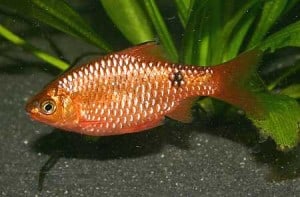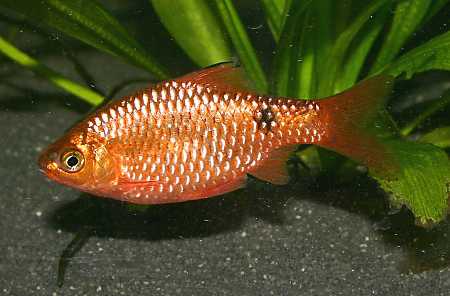
Common name: Rosy Barb
Scientific name: Puntius Conchonius
Average Adult Fish Size: 5.5 inches / 14 cm
Place of Origin: Lakes, and fast moving rivers and streams of India, Bangladesh, Nepal, Pakistan and Afghanistan.
Typical Tank setup: A fully landscaped tank with sturdy live or imitation plants, rocks, driftwood/bogwood. Rosy Barbs will nibble on soft leaved plants, so sturdy plants are best.
Recommended Minimum Aquarium Capacity: 20 gallon / 80 litre for a breeding pair or 30 gallon / 120 litre for a school of 5 Rosy Barbs.
Compatibility: Always keep at least 5 Rosy Barbs together, since this fish will feel very stressed if kept alone. They are a very peaceful fish and do well with other fish of similar size and temperament.
Temperature: 64 – 78 Deg F / 18 – 25.5 Deg C
Water chemistry: pH 6.0 – 8.0
Feeding: Wild Rosy barbs are opportunistic omnivores that feed on plant matter, insects, worms and crustaceans in the wild. They are very good eaters in the aquarium and do well on a varied diet of high quality flakes, pellets and frozen food. Vegetables, such as boiled zucchini and peas are much appreciated. Rosy Barbs will also eat live food if the food is small enough to be considered prey. They also help control excessive algae growth, and some aquarists have reported that Rosy Barbs are a great way of combating hair algae. They will however also feed on the plants in the aquarium, so sensitive soft leaved species should generally be avoided.
Sexing: The female Rosy Barb is silver colored with a red tinge, and the male Rosy barb will change from silver to a rich claret flush during the breeding period. The female will also change during the breeding period and her look becomes more luminous. Female Rosy Barbs tend to grow larger than male Rosy Barbs.
Breeding: Rosy Barbs will scatter their eggs on some form of substrate or simply release them in open water. The female Rosy Barbs can produce hundreds of eggs per spawning. Rosy Barbs do not care for egg or fry and may eat their own offspring. If you want to ensure a higher fry survival, you can set up a separate breeding aquarium. A 20 gallon aquarium is large enough. Preferably include plants in the set up.
Additional Information: Rosy Barbs are available in standard and long-finned varieties


Related Posts
Croaking Gourami – Trichopsis vittatus
Benthochromis Tricoti
Large-eyed Mouthbrooder – Callochromis Macrops